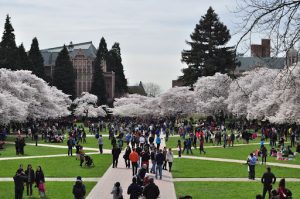6 The Classroom & The Campus
Vanessa Chang, Payton Sullivan, Brandon Iseri

The classroom and the campus are the stage for seemingly all happenings within a university, and undoubtedly influence people’s college going experiences. From before even sending in one’s application, to graduation day and beyond, these characteristics of the university are at play. It is hard to imagine a college experience at the University of Washington without picturing or remembering a story that happened at the quad, one of the libraries, or another favorite spot on campus.
The presence of the classroom and campus in people’s experience at UW became apparent to us during the interviews we conducted. One of our interviewees expressed how they “feel like this year [they are] getting much more of the classic college experience that [they] were looking for when coming to UW”, because the campus feels like a separate community than the city of Seattle in general and she enjoys sitting in the quad or walking around campus. She enjoys these things because of the physical aspects she can observe, like the architecture, and also because they make her feel a sense of belonging in her community. This highlights how the physical campus and classrooms as places factor into and influence the college experience of students, as well as express characteristics of thick institutions.
Thick institutions are organizations that have a set of criteria: physical location/shared tasks, collective rituals, story telling, idiosyncratic local culture, and moral ecology (Brooks 2017). The campus as a place sets the stage for the rest of the characteristics of thick institutions to unfold. The image above of the quad represents characteristics of thick institutions, namely physical place (shared tasks) and collective ritual. The physical place is the quad, which is one of the more popular places to be on campus as illustrated by the image, and this is a place where students can relax, hang out, study, eat, etc. The collective ritual is for students to walk through the quad with friends and classmates daily. In the spring, many people who are associated with the thick institution, the University of Washington, want to take a photo with the cherry blossoms and to feel the atmosphere of the collective ritual among the community.
Shared tasks as a result of shared physical locations, one of the characteristics of thick institutions, are derived from classroom and campus experiences. During the height of the COVID 19 pandemic, this became especially clear with their absence while everyone remained home and quarantined. Samantha Hill’s evaluation of the importance of campus and classrooms describes how “when students walk into a classroom and sit down at the table to learn, discuss, and debate, they appear before one another as equals”, (Hill 2020). Students are equals who are engaging in shared tasks and collective rituals within a local culture. These are all characteristics that describe campus and the classroom as places for thick institutions to be built upon.
Throughout our work this quarter, we have grown to understand how colleges and universities operate as thick institutions, with classrooms and the campus being the foundation for these operations. We did not encounter anything that led us to a strong connection between our topic and the place of sports in the university. The place of sports would likely be a subtopic of the idea of campus and campus activities.
References
- Brooks, D. 18 April 2017. “How to Leave a Mark on People”, The New York Times.
- Hill, S. 2020 June 4. Why We Need Campuses. The Hannah Arendt Center for Politics and Humanities. https://hac.bard.edu/amor-mundi/why-we-need-campuses-2020-06-04#:~:text=The%20space%20of%20the%20campus,from%20a%20stable%20home%20environment.
- Mabel, J. 2014. University of Washington Quad Cherry Blossoms. https://www.flickr.com/photos/jmabel/13348002824

